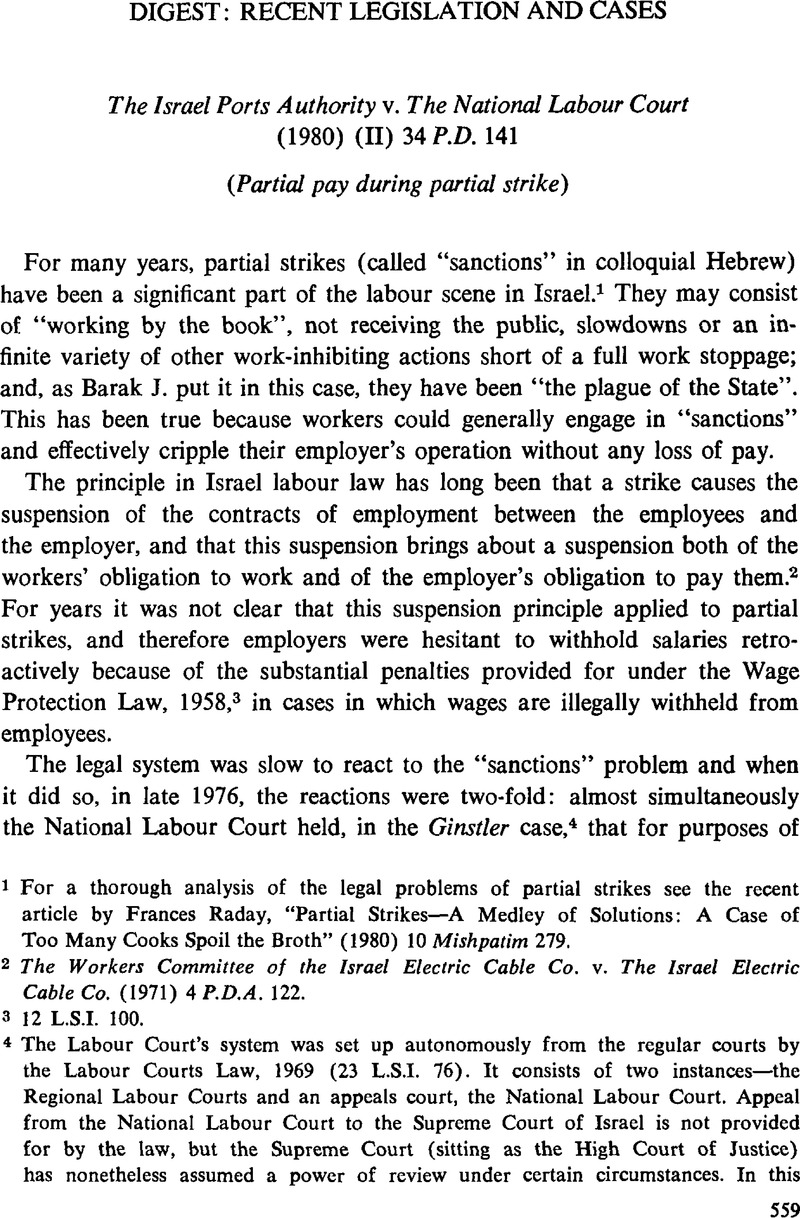No CrossRef data available.
Article contents
Digest: Recent Legislation and Cases
Published online by Cambridge University Press: 12 February 2016
Abstract

- Type
- Notes
- Information
- Copyright
- Copyright © Cambridge University Press and The Faculty of Law, The Hebrew University of Jerusalem 1980
References
1 For a thorough analysis of the legal problems of partial strikes see the recent article by Raday, Frances, “Partial Strikes—A Medley of Solutions: A Case of Too Many Cooks Spoil the Broth” (1980) 10 Mishpatim 279.Google Scholar
2 The Workers Committee of the Israel Electric Cable Co. v. The Israel Electric Cable Co. (1971) 4 P.D.A. 122.
3 12 L.S.I. 100.
4 The Labour Court's system was set up autonomously from the regular courts by the Labour Courts Law, 1969 (23 L.S.I. 76). It consists of two instances—the Regional Labour Courts and an appeals court, the National Labour Court. Appeal from the National Labour Court to the Supreme Court of Israel is not provided for by the law, but the Supreme Court (sitting as the High Court of Justice) has nonetheless assumed a power of review under certain circumstances. In this case, a considerable portion of the judgement is related to the issue of the power of the High Court of Justice to intervene in the decision of the National Labour Court, but since that question is peripheral to the subject of this summary it will not be dealt with at length. Suffice it to say that Barak J. felt that the High Court of Justice had jurisdiction on two grounds. The first (and the only recognized by previous judgements) was the existence of a clear legal mistake on the face of the National Labour Court's judgement. The second, was the great importance of the subject for the country. Landau P. and Ben-Porat J., however, accepted only the first grounds of jurisdiction.
5 Ginstler v. the State of Israel (1976) 8 P.D.A. 3.
6 31 L.S.I. 5.
7 See Raday, supra n. 1, at 281–285 for a thorough analysis of the problem.
8 Supra n. 1, at 287.
page 564 note 1 27 L.S.I. 155. This section is now contained in secs. 245–248 of the Penal Law, 1977 (L.S.I. Special volume).
page 565 note 2 The use of affidavits in this case on behalf both of the plaintiff and defendant arises from the use of the specific summary procedure provided for in the Israeli Rules of Civil Procedure for certain types of actions.
page 566 note 3 The recording of the conversations here predated the adoption of the new Israeli Eavesdropping Law (1979) S.H. No. 38, p. 118, (see English translation in (1980) 15 Is.L.R. 150) which prohibits recording of conversations under certain circumstances. However, even if the new law had been in effect it would not appear to have prohibited these recordings or affected their admissibility in court as they were done with the consent of one of the parties to the conversation i.e., Simona. See Goldstein, S. and Schottenfels, D., “Digest: Recent Legislation and Cases” (1980) 15 Is.L.R. 144.Google Scholar It should also be noted that in his opinion for the court, Landau, D.P. rejected the arguments that the defendants could not be convicted of attempting to induce Simona to give false testimony or withdraw his testimony since he had made up his mind not to be induced and was only participating in the conversations so as to obtain evidence against them. He also rejected the argument that the activities of the police here amounted to “entrapment”.
page 567 note 4 Since the time of this decision, Justice Landau has been elevated to President of the Supreme Court.


